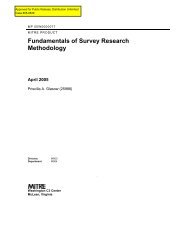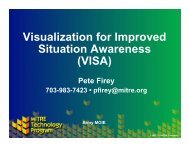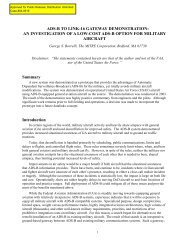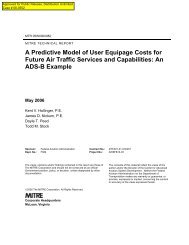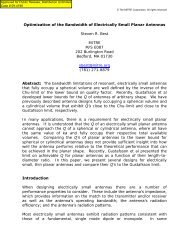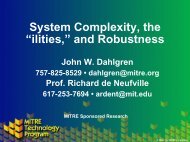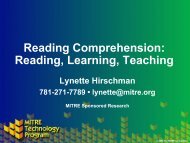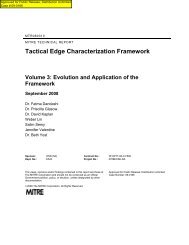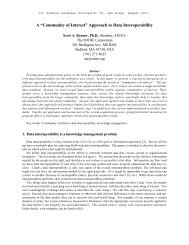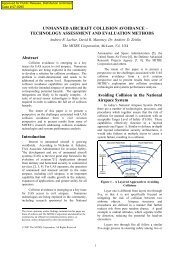Human-in-the-Loop Simulations of Surface Trajectory-Based ... - Mitre
Human-in-the-Loop Simulations of Surface Trajectory-Based ... - Mitre
Human-in-the-Loop Simulations of Surface Trajectory-Based ... - Mitre
Create successful ePaper yourself
Turn your PDF publications into a flip-book with our unique Google optimized e-Paper software.
N<strong>in</strong>th USA/Europe Air Traffic Management Research and Development Sem<strong>in</strong>ar (ATM2011)<br />
<strong>Human</strong>-<strong>in</strong>-<strong>the</strong>-<strong>Loop</strong> <strong>Simulations</strong> <strong>of</strong> <strong>Surface</strong><br />
<strong>Trajectory</strong>-<strong>Based</strong> Operations<br />
An Evaluation <strong>of</strong> Taxi Rout<strong>in</strong>g and <strong>Surface</strong> Conformance Monitor<strong>in</strong>g Decision Support Tool<br />
Capabilities<br />
Emily K. Stelzer, Constance E. Morgan, Kathleen A. McGarry, Kathryn A. Kle<strong>in</strong>, and Karol Kerns<br />
Center for Advanced Aviation Systems Development<br />
The MITRE Corporation<br />
McLean, VA<br />
Abstract— The Federal Aviation Adm<strong>in</strong>istration’s Next<br />
Generation Air Transportation System (NextGen) concept<br />
proposes a suite <strong>of</strong> decision support tools for use <strong>in</strong> <strong>the</strong> air<br />
traffic control tower to support safe and efficient operations.<br />
This paper describes <strong>the</strong> proposed set <strong>of</strong> automation<br />
capabilities to support ground and local controller activities <strong>in</strong><br />
<strong>the</strong> NextGen mid-term (2018), <strong>in</strong>clud<strong>in</strong>g automated decision<br />
support tools to generate taxi routes and monitor pilot<br />
conformance to <strong>the</strong> assigned taxi route. To evaluate <strong>the</strong>se<br />
capabilities, The MITRE Corporation’s Center for Advanced<br />
Aviation System Development (CAASD) conducted two<br />
human-<strong>in</strong>-<strong>the</strong>-loop experiments to evaluate ground controller<br />
performance with <strong>the</strong>se decision support tools, focus<strong>in</strong>g on<br />
automation to support taxi route generation and conformance<br />
monitor<strong>in</strong>g. These simulations specifically exam<strong>in</strong>ed<br />
capabilities provided <strong>in</strong> surface automation designed by<br />
Mosaic ATM. This paper describes <strong>the</strong> results <strong>of</strong> those two<br />
experiments and discusses necessary future research to ref<strong>in</strong>e<br />
and validate <strong>the</strong> NextGen surface decision support tool<br />
concepts.<br />
Keywords-surface automation; taxi rout<strong>in</strong>g; conformance<br />
monitor<strong>in</strong>g; human performance<br />
I. SURFACE TRAJECTORY-BASED OPERATIONS<br />
The Next Generation Air Transportation System (NextGen)<br />
is <strong>the</strong> Federal Aviation Adm<strong>in</strong>istration’s (FAA’s) concept for<br />
moderniz<strong>in</strong>g <strong>the</strong> National Airspace System through 2018.<br />
Through NextGen, <strong>the</strong> FAA is address<strong>in</strong>g <strong>the</strong> impact <strong>of</strong> air<br />
traffic growth by <strong>in</strong>creas<strong>in</strong>g national airspace (NAS) capacity<br />
and efficiency while simultaneously improv<strong>in</strong>g safety, reduc<strong>in</strong>g<br />
environmental impacts, and <strong>in</strong>creas<strong>in</strong>g user access to <strong>the</strong> NAS.<br />
High-density airports <strong>in</strong> <strong>the</strong> NextGen mid-term timeframe<br />
(~2018) are expected to operate with a set <strong>of</strong> <strong>in</strong>tegrated<br />
automation decision support tools (DSTs), which <strong>in</strong>clude <strong>the</strong><br />
follow<strong>in</strong>g attributes: access to timely and dynamically updated<br />
<strong>in</strong>formation; a means for collaboration with stakeholders;<br />
maximization <strong>of</strong> airport capacity; and improved efficiency <strong>of</strong><br />
airport and surface operations [1]. The DSTs described <strong>in</strong> <strong>the</strong><br />
NextGen concept are <strong>the</strong> basis for an operational concept<br />
known as <strong>Surface</strong> <strong>Trajectory</strong>-<strong>Based</strong> Operations (STBO) that<br />
will manage traffic flows and resources on <strong>the</strong> airport surface<br />
and will enable surface trajectory-based operations <strong>in</strong> <strong>the</strong> farterm.<br />
This program is managed by <strong>the</strong> FAA’s Aviation<br />
Research and Technology Development Office, and <strong>in</strong>cludes<br />
contributions from Mosaic ATM, MITRE, MCR LLC, and <strong>the</strong><br />
John A. Volpe National Transportation Systems Center.<br />
A. Concept Overview<br />
© The MITRE Corporation. All rights reserved<br />
The need for STBO is derived from a set <strong>of</strong> identified<br />
shortfalls <strong>in</strong> <strong>the</strong> current operations that do not meet NextGen<br />
needs [2]. In today’s operations, periods <strong>of</strong> high demand <strong>of</strong>ten<br />
result <strong>in</strong> departure delays and long physical queues. While<br />
current surface operations tend to be tactical and reactive <strong>in</strong><br />
nature, operations under NextGen will need to be strategic and<br />
predictive.<br />
STBO is expected to <strong>in</strong>crease airport surface efficiencies<br />
through shared situation awareness and local collaboration,<br />
allow<strong>in</strong>g operators to work proactively to manage high surface<br />
demand and dynamic surface and airspace constra<strong>in</strong>ts. The<br />
shared situation awareness generated by STBO will support all<br />
stakeholders <strong>in</strong> surface operations. A common <strong>in</strong>terface with<br />
flight operators, airport operators, and surface traffic<br />
management systems will enable collaboration.<br />
In addition to support<strong>in</strong>g improved situation awareness,<br />
STBO is also expected to support better decision-mak<strong>in</strong>g<br />
through local <strong>in</strong>formation shar<strong>in</strong>g and automated DSTs [3].<br />
These DSTs will share data with o<strong>the</strong>r NAS doma<strong>in</strong>s, which<br />
will contribute to an <strong>in</strong>crease <strong>in</strong> operational efficiency. The<br />
capabilities <strong>of</strong> <strong>the</strong>se DSTs will assist <strong>in</strong> <strong>the</strong> execution <strong>of</strong> Air<br />
Traffic Control Tower (ATCT) responsibilities by provid<strong>in</strong>g<br />
recommendations to improve throughput and reduce delays for<br />
surface operations. These recommendations will take <strong>in</strong>to<br />
account flight plan data, flight operator preferences, constra<strong>in</strong>ts<br />
from o<strong>the</strong>r NAS doma<strong>in</strong>s (e.g., flow constra<strong>in</strong>ts), and local<br />
airport operational data [4]. The automated capabilities<br />
envisioned as part <strong>of</strong> <strong>the</strong> STBO concept are expected to assist<br />
tower controllers <strong>in</strong> perform<strong>in</strong>g <strong>the</strong>ir tasks and may reduce<br />
<strong>the</strong>ir workload [2].
STBO capabilities are expected to be developed and<br />
<strong>in</strong>troduced <strong>in</strong> phases [2]. An <strong>in</strong>itial implementation, to be<br />
deployed by <strong>the</strong> NextGen midterm (~2018), will <strong>in</strong>clude<br />
flight-specific data exchange between FAA facilities and<br />
stakeholders and will provide foundational DST capabilities to<br />
assist <strong>the</strong> tower <strong>in</strong> manag<strong>in</strong>g <strong>the</strong> airport configuration,<br />
assign<strong>in</strong>g runways for depart<strong>in</strong>g flights, and manag<strong>in</strong>g runway<br />
queues. Mov<strong>in</strong>g through <strong>the</strong> NextGen mid-term timeframe,<br />
<strong>the</strong>se <strong>in</strong>itial DST capabilities will be enhanced and additional<br />
DSTs will be implemented to develop recommendations for<br />
optimiz<strong>in</strong>g airport configurations and flight-specific runway<br />
assignments; to provide for collaboration with flight operators<br />
for surface schedul<strong>in</strong>g; and to <strong>in</strong>troduce two-dimensional taxi<br />
rout<strong>in</strong>g and surface conformance monitor<strong>in</strong>g capabilities. Into<br />
<strong>the</strong> far-term, DST capabilities will be enhanced to use surface<br />
trajectory model<strong>in</strong>g as <strong>the</strong> basis <strong>of</strong> automated decision mak<strong>in</strong>g<br />
and conformance monitor<strong>in</strong>g; surface operations will be<br />
<strong>in</strong>tegrated with airborne trajectory-based operations.<br />
B. STBO Capabilities <strong>in</strong> <strong>the</strong> NextGen Mid-term<br />
The STBO concept elements will be implemented as<br />
automated DSTs that support surface operations. These<br />
automated DSTs are envisioned to support (1) airport<br />
configuration management, (2) runway assignment, (3)<br />
schedul<strong>in</strong>g and sequenc<strong>in</strong>g, and (4) taxi rout<strong>in</strong>g 1 . Descriptions<br />
<strong>of</strong> <strong>the</strong> mid-term capabilities for <strong>the</strong> STBO DSTs follow.<br />
1) Airport Configuration Management<br />
Airport configuration management capabilities will assist<br />
Air Traffic Control <strong>in</strong> plann<strong>in</strong>g and decision-mak<strong>in</strong>g for airport<br />
configuration changes to improve <strong>the</strong> utilization <strong>of</strong> runways.<br />
These automated capabilities will be based on arrival and<br />
departure demand, with consideration <strong>of</strong> external factors, such<br />
as wea<strong>the</strong>r. The prescribed airport configuration will <strong>in</strong>clude<br />
runways for arrivals, departures, or mixed use; taxiway<br />
segments, whe<strong>the</strong>r open or closed; and standard operat<strong>in</strong>g<br />
procedures for <strong>the</strong> airport. The airport configuration<br />
capabilities support collaborative decision mak<strong>in</strong>g among <strong>the</strong><br />
NAS doma<strong>in</strong>s, coord<strong>in</strong>ation with <strong>the</strong> airport authority, and<br />
dissem<strong>in</strong>ation <strong>of</strong> <strong>the</strong> configuration change to <strong>the</strong> stakeholders.<br />
The concept for airport configuration management will apply<br />
to both surface arrival and departure operations and will<br />
enhance <strong>the</strong> efficiency <strong>of</strong> <strong>the</strong>se operations.<br />
2) Runway Assignment<br />
Runway assignment capabilities will assist controllers <strong>in</strong><br />
early plann<strong>in</strong>g <strong>of</strong> flight-specific departure runway assignment<br />
based on factors such as <strong>the</strong> filed departure route, <strong>the</strong> airport<br />
configuration, aircraft type, projected runway load<strong>in</strong>g, and<br />
flight operator preferences, requirements, and limitations [5].<br />
Departure runway assignments for a flight and any updates will<br />
be shared with flight operators and available to NAS doma<strong>in</strong>s.<br />
The automation capabilities will display runway assignment<br />
recommendations to Ground Control, who will be able to enter<br />
or modify a runway assignment for a flight. Runway<br />
1 Also support<strong>in</strong>g surface operations is an additional DST that<br />
supports departure rout<strong>in</strong>g. This capability is also planned to<br />
be supported on <strong>the</strong> TFDM platform as one <strong>of</strong> <strong>the</strong> <strong>in</strong>tegrated<br />
DSTs, but is outside <strong>the</strong> scope <strong>of</strong> current STBO concepts and<br />
will not be addressed fur<strong>the</strong>r <strong>in</strong> this paper.<br />
© The MITRE Corporation. All rights reserved<br />
Assignment capabilities will enable plann<strong>in</strong>g for surface<br />
operations by flight operators and air traffic management as<br />
well as will improve airport throughput by balanc<strong>in</strong>g departure<br />
runways.<br />
3) Schedul<strong>in</strong>g and Sequenc<strong>in</strong>g<br />
Schedul<strong>in</strong>g and Sequenc<strong>in</strong>g capabilities will assist<br />
controllers <strong>in</strong> manag<strong>in</strong>g <strong>the</strong> surface schedule and runway<br />
sequences for both arrivals and departures and will support<br />
collaboration with flight operators. Sequenc<strong>in</strong>g support<br />
provides guidance on <strong>the</strong> suggested order <strong>of</strong> aircraft <strong>in</strong> a queue,<br />
while schedul<strong>in</strong>g support <strong>in</strong>volves time-based<br />
recommendations. The surface schedule and sequence will<br />
satisfy traffic management constra<strong>in</strong>ts and controlled departure<br />
times and will optimize <strong>the</strong> use <strong>of</strong> surface resources to meet <strong>the</strong><br />
demand. The automated capabilities will provide sequenc<strong>in</strong>g<br />
recommendations based on <strong>the</strong> data known about <strong>the</strong> flight,<br />
such as <strong>the</strong> time <strong>the</strong> flight entered to <strong>the</strong> airport movement area<br />
and <strong>the</strong> location <strong>of</strong> <strong>the</strong> entrance to airport movement area<br />
relative to <strong>the</strong> departure runway. Schedul<strong>in</strong>g and sequenc<strong>in</strong>g<br />
capabilities will improve airport throughput, provide solutions<br />
that comply with NAS constra<strong>in</strong>ts, improve flight operator<br />
efficiencies, and support collaboration with flight operators to<br />
meet <strong>the</strong>ir bus<strong>in</strong>ess needs.<br />
4) Taxi Rout<strong>in</strong>g<br />
Taxi Rout<strong>in</strong>g capabilities address both taxi route generation<br />
and surface conformance monitor<strong>in</strong>g. Taxi route generation<br />
capabilities will consider current aircraft position, aircraft<br />
surface dest<strong>in</strong>ation (e.g., <strong>the</strong> assigned departure runway), and<br />
<strong>the</strong> airport configuration (runway use and taxiway or runway<br />
closures), user preferences for gate and taxiway, and o<strong>the</strong>r<br />
relevant factors to propose to <strong>the</strong> controller an appropriate taxi<br />
route for a flight. In earlier operational timeframes, <strong>the</strong>se are<br />
pre-def<strong>in</strong>ed taxi routes, while later timeframes may also<br />
<strong>in</strong>clude ad hoc routes, and far<strong>the</strong>r <strong>in</strong>to <strong>the</strong> future, full surface<br />
trajectories. Taxi route generation capabilities also support<br />
data l<strong>in</strong>k <strong>of</strong> <strong>the</strong> taxi route to <strong>the</strong> aircraft. <strong>Surface</strong> conformance<br />
monitor<strong>in</strong>g capabilities will assist <strong>the</strong> controllers <strong>in</strong> monitor<strong>in</strong>g<br />
<strong>the</strong> aircraft’s conformance with its assigned taxi <strong>in</strong>structions.<br />
Taxi rout<strong>in</strong>g and surface conformance monitor<strong>in</strong>g capabilities<br />
serve as <strong>the</strong> focal po<strong>in</strong>t for <strong>the</strong> set <strong>of</strong> simulations described <strong>in</strong><br />
this paper. Thus, a more detailed description <strong>of</strong> <strong>the</strong> taxi rout<strong>in</strong>g<br />
decision support tools and a set <strong>of</strong> use cases for <strong>the</strong>se<br />
capabilities are described below.<br />
II. TAXI ROUTING DECISION SUPPORT TOOLS<br />
A taxi route describes <strong>the</strong> path on <strong>the</strong> surface that an aircraft<br />
uses to traverse <strong>the</strong> airport movement area from one location to<br />
ano<strong>the</strong>r. In current operations, ground control receives a pilot<br />
request for taxi and uses <strong>in</strong>formation he or she knows about <strong>the</strong><br />
airport configuration, operational procedures, and flight<br />
<strong>in</strong>formation (e.g., departure route and aircraft size) to develop<br />
an operationally acceptable taxi route. These routes may be<br />
pre-def<strong>in</strong>ed standard routes that are commonly used at an<br />
airport facility or may be determ<strong>in</strong>ed ad hoc to fit a specific<br />
situation. An operationally acceptable taxi route is one that is<br />
efficient and does not compromise safety. In current<br />
operations, <strong>the</strong> taxi route is voiced to <strong>the</strong> pilot over <strong>the</strong> radio<br />
frequency, which may result <strong>in</strong> misunderstand<strong>in</strong>gs or read-back<br />
errors. Today’s tactical response to a pilot’s call for taxi can
<strong>in</strong>hibit or limit efficiency <strong>in</strong> <strong>the</strong> current operation. In addition,<br />
<strong>the</strong> taxi route <strong>in</strong>formation is not stored electronically <strong>in</strong> any<br />
way so it is not available to be used by o<strong>the</strong>r capabilities or<br />
systems.<br />
A. Taxi Rout<strong>in</strong>g under Nom<strong>in</strong>al Conditions<br />
Automated taxi route generation capabilities will consider a<br />
flight’s surface orig<strong>in</strong> and dest<strong>in</strong>ation and take <strong>in</strong>to account <strong>the</strong><br />
airport configuration (i.e., both current and planned<br />
configurations); <strong>the</strong> runway assignment, which is provided by<br />
<strong>the</strong> runway assignment DST; flight operator preferences; and<br />
o<strong>the</strong>r relevant factors to propose an appropriate taxi route to <strong>the</strong><br />
controller. The taxi route generation capabilities <strong>in</strong> <strong>the</strong><br />
NextGen mid-term will also provide automation support for<br />
selection <strong>of</strong> a pre-def<strong>in</strong>ed taxi route. To enhance safety, a<br />
hold-short will be <strong>in</strong>serted automatically when a taxi route<br />
crosses a runway. To ensure that <strong>the</strong> controller always has<br />
f<strong>in</strong>al authority over an assigned route, <strong>the</strong> ground controller<br />
will be able to modify a suggested route, add any additional<br />
<strong>in</strong>structions (for example, a hold short at a merge po<strong>in</strong>t to<br />
sequence traffic), or develop a manual ad hoc route. Under <strong>the</strong><br />
mid-term vision, a controller will <strong>the</strong>n verbally issue <strong>the</strong> route<br />
to <strong>the</strong> pilot.<br />
Taxi route generation will improve efficiencies <strong>in</strong> surface<br />
operations by optimiz<strong>in</strong>g taxi routes and provid<strong>in</strong>g a digital<br />
route <strong>in</strong>struction for use with o<strong>the</strong>r automation capabilities,<br />
<strong>in</strong>clud<strong>in</strong>g data l<strong>in</strong>k to <strong>the</strong> pilot which will reduce taxi route<br />
misunderstand<strong>in</strong>gs and read-back errors. To demonstrate <strong>the</strong><br />
benefit <strong>of</strong> <strong>the</strong> taxi route generation automation, a scenario is<br />
presented below to highlight <strong>the</strong> use <strong>of</strong> this tool under nom<strong>in</strong>al<br />
conditions.<br />
In this scenario for a depart<strong>in</strong>g flight, <strong>the</strong> ramp area is<br />
controlled by a ramp tower. When a flight plan is filed and an<br />
expected departure runway assignment is generated, an<br />
expected taxi route will also be generated and <strong>the</strong>se data and<br />
any updates will be shared with flight operators and available<br />
for use by o<strong>the</strong>r NAS doma<strong>in</strong>s. Both <strong>the</strong> flight operator and <strong>the</strong><br />
surface automation will use <strong>the</strong> expected runway assignment<br />
and expected taxi route <strong>in</strong> surface operations plann<strong>in</strong>g. The<br />
pilot <strong>of</strong> a depart<strong>in</strong>g flight will call <strong>the</strong> ramp tower when <strong>the</strong><br />
pilot is ready for pushback. The ramp tower manages and<br />
coord<strong>in</strong>ates with ATC regard<strong>in</strong>g <strong>the</strong> flight’s pushback and<br />
provides taxi <strong>in</strong>structions for <strong>the</strong> flight to maneuver to a<br />
location where <strong>the</strong> pilot can enter <strong>the</strong> active movement area.<br />
As <strong>the</strong> pilot beg<strong>in</strong>s push<strong>in</strong>g back, <strong>the</strong> taxi rout<strong>in</strong>g capability <strong>in</strong><br />
<strong>the</strong> STBO automation <strong>in</strong> <strong>the</strong> ATCT provides a suggested taxi<br />
route assignment to Ground Control, displayed as part <strong>of</strong> <strong>the</strong><br />
electronic flight data. When ready to enter <strong>the</strong> airport<br />
movement area (AMA), <strong>the</strong> pilot calls Ground Control for taxi<br />
<strong>in</strong>structions and clearance onto <strong>the</strong> AMA. When <strong>the</strong> pilot calls<br />
for taxi, Ground Control reviews <strong>the</strong> suggested departure<br />
runway (surface dest<strong>in</strong>ation <strong>of</strong> <strong>the</strong> taxi route), <strong>the</strong> suggested<br />
taxi route, and reviews <strong>the</strong> current situation (via a surface<br />
surveillance display, electronic flight data display, or <strong>the</strong><br />
w<strong>in</strong>dow view). In this scenario, <strong>the</strong> taxi route to runway 17R is<br />
to taxi via Kilo, turn right at K7, turn left at Lima hold short <strong>of</strong><br />
Zulu, proceed on Lima, right on EH. See Figure 1.<br />
Work was funded by <strong>the</strong> Federal Aviation Adm<strong>in</strong>istration<br />
Hold<br />
Short<br />
Po<strong>in</strong>t<br />
© The MITRE Corporation. All rights reserved<br />
Taxi<br />
Route<br />
Figure 1. Taxi route.<br />
This is a standard taxi route and <strong>the</strong> <strong>in</strong>itial segment to <strong>the</strong><br />
hold short <strong>of</strong> Zulu is voiced to <strong>the</strong> pilot as: ―…runway 17R,<br />
taxi via Kilo, Kilo Seven, Lima, hold short <strong>of</strong> Zulu.‖ The pilot<br />
acknowledges <strong>the</strong> route and beg<strong>in</strong>s to taxi while <strong>the</strong> Ground<br />
Controller pushes a s<strong>in</strong>gle button to acknowledge <strong>the</strong> taxi route<br />
and <strong>in</strong>dicate <strong>in</strong> <strong>the</strong> automation that <strong>the</strong> flight is taxi<strong>in</strong>g. To<br />
release <strong>the</strong> flight from <strong>the</strong> hold short, <strong>the</strong> Ground Controller<br />
contacts <strong>the</strong> pilot and voices: ―…cont<strong>in</strong>ue taxi via Lima and<br />
Echo Hotel, monitor tower.‖ The pilot acknowledges <strong>the</strong><br />
rema<strong>in</strong>der <strong>of</strong> <strong>the</strong> route while <strong>the</strong> Ground Controller pushes a<br />
button to remove <strong>the</strong> hold short from <strong>the</strong> automation and to<br />
forward <strong>the</strong> electronic flight data to <strong>the</strong> Local Controller who<br />
manages arrivals and departures on <strong>the</strong> runway.<br />
B. <strong>Surface</strong> Conformance Monitor<strong>in</strong>g<br />
In surface conformance monitor<strong>in</strong>g, an aircraft’s location <strong>in</strong><br />
<strong>the</strong> airport movement area is compared with its assigned taxi<br />
route to determ<strong>in</strong>e whe<strong>the</strong>r <strong>the</strong> aircraft is on its assigned route<br />
or is out <strong>of</strong> conformance with its assigned route. In today’s<br />
operation, conformance monitor<strong>in</strong>g is one <strong>of</strong> Ground Control’s<br />
responsibilities and depends on human observation out <strong>the</strong><br />
w<strong>in</strong>dow. Today’s surface surveillance, Airport Movement<br />
Area Safety System/Airport <strong>Surface</strong> Detection Equipment<br />
Model X (AMASS/ASDE-X), provide alerts for imm<strong>in</strong>ent<br />
safety issues: when taxi<strong>in</strong>g aircraft <strong>in</strong> <strong>the</strong> airport movement<br />
area enter a runway that has mov<strong>in</strong>g aircraft on or approach<strong>in</strong>g<br />
<strong>the</strong> runway. Currently, <strong>the</strong>re is no automation support for<br />
controllers <strong>in</strong> monitor<strong>in</strong>g conformance to taxi rout<strong>in</strong>g. When<br />
Ground Control observes an aircraft deviate from its assigned<br />
taxi route or when <strong>the</strong>re is an alert by surface surveillance <strong>of</strong> an<br />
imm<strong>in</strong>ent safety issue, <strong>the</strong> controller focuses on <strong>the</strong> situation<br />
until it is resolved. This focus dim<strong>in</strong>ishes Ground Control’s<br />
attention to o<strong>the</strong>r aircraft or tasks, potentially caus<strong>in</strong>g o<strong>the</strong>r<br />
tasks to be delayed until this issue is resolved.<br />
In <strong>the</strong> NextGen timeframe, surface conformance monitor<strong>in</strong>g<br />
will be reliant on surface surveillance capabilities. The<br />
automation will compare <strong>the</strong> aircraft’s current location with its<br />
assigned taxi route and will determ<strong>in</strong>e if <strong>the</strong> aircraft is <strong>in</strong><br />
conformance or out <strong>of</strong> conformance. When <strong>the</strong> aircraft is out<br />
<strong>of</strong> conformance, alert<strong>in</strong>g will be based on severity <strong>of</strong> <strong>the</strong><br />
impact <strong>of</strong> <strong>the</strong> nonconformance. The concept envisions a visual<br />
alert to <strong>the</strong> controller and an additional aural alert for safetyrelated<br />
surface conformance issues. There will also be support<br />
for out-<strong>of</strong>-conformance alerts to <strong>the</strong> flight crew via data<br />
l<strong>in</strong>k. Out-<strong>of</strong>-conformance conditions <strong>in</strong>clude, for example, an<br />
aircraft failure to turn when <strong>the</strong>re is a turn <strong>in</strong> <strong>the</strong> assigned taxi<br />
route and an aircraft turn<strong>in</strong>g <strong>of</strong>f <strong>the</strong> assigned taxi route when<br />
<strong>the</strong> turn is not <strong>in</strong> <strong>the</strong> assigned taxi route.<br />
In addition to <strong>the</strong>se location-based conditions, out-<strong>of</strong>conformance<br />
conditions that relate to aircraft velocity will also
e def<strong>in</strong>ed. One example <strong>in</strong>cludes an aircraft fail<strong>in</strong>g to move<br />
when <strong>in</strong>structed to move, such as an aircraft that fails to beg<strong>in</strong><br />
<strong>the</strong> take <strong>of</strong>f roll when cleared for take-<strong>of</strong>f. Ano<strong>the</strong>r example <strong>of</strong><br />
a velocity-based nonconformance condition <strong>in</strong>cludes an aircraft<br />
mov<strong>in</strong>g without be<strong>in</strong>g <strong>in</strong>structed to move, such as an aircraft<br />
pass<strong>in</strong>g a hold-short po<strong>in</strong>t or beg<strong>in</strong>n<strong>in</strong>g a take-<strong>of</strong>f roll without<br />
clearance. Automated surface conformance monitor<strong>in</strong>g will<br />
support <strong>in</strong>creased efficiency <strong>of</strong> surface operations by ensur<strong>in</strong>g<br />
taxi<strong>in</strong>g aircraft compliance with assigned taxi routes and airport<br />
safety by detect<strong>in</strong>g out <strong>of</strong> conformance aircraft movement that<br />
may contribute to runway <strong>in</strong>cursions, potentially reduc<strong>in</strong>g <strong>the</strong><br />
opportunities lead<strong>in</strong>g to runway <strong>in</strong>cursions.<br />
Us<strong>in</strong>g <strong>the</strong> scenario described above (see Figure 1), <strong>the</strong><br />
identified flight can be out <strong>of</strong> conformance with its assigned<br />
taxi route <strong>in</strong> several ways. First, <strong>the</strong> flight may make a turn at<br />
Kilo Eight, turn<strong>in</strong>g <strong>of</strong>f <strong>of</strong> <strong>the</strong> prescribed route. In this case,<br />
Ground Control would be alerted <strong>of</strong> this out-<strong>of</strong>-conformance<br />
condition with visual alerts on <strong>the</strong> map and flight display. An<br />
aural alert would not be provided, as this event was not<br />
currently safety critical as <strong>the</strong> flight is not threaten<strong>in</strong>g a<br />
runway. In respond<strong>in</strong>g to <strong>the</strong> visual alert, Ground Control<br />
would assess <strong>the</strong> situation and take corrective action to address<br />
<strong>the</strong> nonconformance condition. The corrective action may<br />
<strong>in</strong>volve <strong>the</strong> controller modify<strong>in</strong>g <strong>the</strong> taxi route <strong>in</strong> <strong>the</strong><br />
automation to <strong>in</strong>clude <strong>the</strong> wrong turn or communicat<strong>in</strong>g with<br />
<strong>the</strong> pilot to clarify <strong>the</strong> rema<strong>in</strong>der <strong>of</strong> <strong>the</strong> route. When <strong>the</strong> taxi<strong>in</strong>g<br />
flight is back <strong>in</strong> conformance with its assigned route, <strong>the</strong> alert<br />
would clear.<br />
Second, <strong>the</strong> flight may fail to make <strong>the</strong> turn on Lima,<br />
cont<strong>in</strong>u<strong>in</strong>g straight on Kilo Eight and approach<strong>in</strong>g <strong>the</strong> runway.<br />
If <strong>the</strong> aircraft failed to hold short <strong>of</strong> <strong>the</strong> runway, a safety critical<br />
alert would be issued to <strong>the</strong> controller <strong>in</strong> both <strong>the</strong> visual and<br />
auditory modality.<br />
Assum<strong>in</strong>g <strong>the</strong> aircraft has made <strong>the</strong> appropriate turn at<br />
Lima and is head<strong>in</strong>g along <strong>the</strong> route displayed <strong>in</strong> Figure 1, and<br />
additional nonconformance event could occur if <strong>the</strong> aircraft<br />
fails to hold short <strong>of</strong> Zulu. This non-safety critical event would<br />
be alerted visually to Ground Control. In respond<strong>in</strong>g to <strong>the</strong><br />
alert, Ground Control would assess <strong>the</strong> situation and take<br />
necessary action to address <strong>the</strong> error by <strong>in</strong>struct<strong>in</strong>g <strong>the</strong> pilot to<br />
stop or hold short <strong>of</strong> a subsequent <strong>in</strong>tersection if needed.<br />
III. RESEARCH QUESTIONS<br />
Extensive work has been conducted def<strong>in</strong><strong>in</strong>g <strong>the</strong> concept <strong>of</strong><br />
use for <strong>the</strong>se new technologies [4, 5]. The scenarios described<br />
above provide a concrete representation <strong>of</strong> how <strong>the</strong>se<br />
technologies are envisioned to work and be used under<br />
NextGen. Despite <strong>the</strong>se accomplishments, a series <strong>of</strong> research<br />
questions need to be addressed before <strong>the</strong>se technologies can<br />
be implemented <strong>in</strong> <strong>the</strong> operational environment. These<br />
questions address both <strong>the</strong> measurable benefit associated with<br />
<strong>the</strong> taxi rout<strong>in</strong>g and conformance monitor<strong>in</strong>g decision support<br />
tool and <strong>the</strong> acceptance <strong>of</strong> <strong>the</strong>se capabilities by <strong>the</strong> operational<br />
community:<br />
Do controllers assign automation-generated taxi routes<br />
to departure aircraft?<br />
Do surface conformance monitor<strong>in</strong>g capabilities<br />
improve controllers’ response to nonconformance<br />
events?<br />
Do controllers trust <strong>the</strong> automation?<br />
Do changes <strong>in</strong> traffic load impact <strong>the</strong>se f<strong>in</strong>d<strong>in</strong>gs?<br />
IV. HUMAN-IN-THE-LOOP SIMULATIONS<br />
A roadmap has been developed by The MITRE<br />
Corporation’s Center for Advanced Aviation System<br />
Development (CAASD) to outl<strong>in</strong>e a set <strong>of</strong> human-<strong>in</strong>-<strong>the</strong>-loop<br />
simulations to address <strong>the</strong> research questions stated above.<br />
This roadmap describes a systematic approach for conduct<strong>in</strong>g a<br />
total <strong>of</strong> six evaluations, which will empirically evaluate <strong>the</strong> five<br />
STBO decision support tools that are envisioned under<br />
NextGen. These simulations are projected to occur biannually<br />
through 2012.<br />
This paper details <strong>the</strong> methods and results from <strong>the</strong> first two<br />
simulations, which took place dur<strong>in</strong>g 2010. These simulations<br />
were designed to exam<strong>in</strong>e <strong>the</strong> human performance implications<br />
associated with <strong>the</strong> use <strong>of</strong> <strong>in</strong>itial prototype taxi route generation<br />
capabilities, <strong>in</strong>clud<strong>in</strong>g <strong>the</strong> surface conformance monitor<strong>in</strong>g<br />
tools that are projected to be implemented <strong>in</strong> <strong>the</strong> mid-term plan<br />
for NextGen. These simulations exam<strong>in</strong>ed <strong>the</strong> use <strong>of</strong> <strong>the</strong>se<br />
technologies by tra<strong>in</strong>ed air traffic controllers, employed by <strong>the</strong><br />
Federal Aviation Adm<strong>in</strong>istration (FAA), <strong>in</strong> a high-fidelity<br />
tower simulation. The follow<strong>in</strong>g sections outl<strong>in</strong>e <strong>the</strong> methods<br />
used to evaluate <strong>the</strong> stated research questions, as well as results<br />
produced from <strong>the</strong> simulations.<br />
A. Simulation 1<br />
© The MITRE Corporation. All rights reserved<br />
1) Methods<br />
a) Participants: Thirteen FAA employees, who reported<br />
an average <strong>of</strong> 22.5 years <strong>of</strong> experience controll<strong>in</strong>g traffic,<br />
participated <strong>in</strong> <strong>the</strong> study. At <strong>the</strong> time <strong>of</strong> <strong>the</strong> simulation, seven<br />
<strong>in</strong>dividuals were serv<strong>in</strong>g <strong>in</strong> roles at <strong>the</strong> FAA Headquarters,<br />
while <strong>the</strong> rema<strong>in</strong><strong>in</strong>g six participants came from facilities<br />
<strong>in</strong>clud<strong>in</strong>g M<strong>in</strong>neapolis – St. Paul International (MSP), Great<br />
Falls International (GTF), Phoenix Sky Harbor International<br />
Airport (PHX), Long Beach (LGB), Baltimore Wash<strong>in</strong>gton<br />
International (BWI), Albuquerque International Sunport<br />
(ABQ). The participants ranged <strong>in</strong> age from 32 to 56 years (M<br />
= 46.7 years). Three <strong>of</strong> <strong>the</strong> participants were female, while <strong>the</strong><br />
rema<strong>in</strong><strong>in</strong>g ten particpiants were male. None <strong>of</strong> <strong>the</strong> participants<br />
had worked at Dallas Fort Worth International Airport (DFW),<br />
which served as <strong>the</strong> simulated site for <strong>the</strong> study.<br />
b) Simulation Environment: The simulation was<br />
conducted at <strong>the</strong> MITRE Corporation’s Center for Advanced<br />
Aviation System Development’s (CAASD) Aviation<br />
Integration Demonstration and Experimentation for<br />
Aeronautics (IDEA) laboratory. CAASD’s air traffic control<br />
tower simulator was used to generate a high fidelity<br />
representation <strong>of</strong> DFW dur<strong>in</strong>g a standard south flow operation<br />
(see Figure 2).
Figure 2. Air traffic control tower simulator.<br />
Configurable workstations were located directly below <strong>the</strong><br />
out-<strong>the</strong>-w<strong>in</strong>dow scene and <strong>in</strong>cluded displays to emulate <strong>the</strong><br />
Digital Bright Radar Indicator Tower Equipment (DBRITE)<br />
system. In addition, workstations were outfitted with an<br />
electronic flight strip display and a surface surface map<br />
display that were developed by Mosaic ATM. These displays<br />
are shown <strong>in</strong> Figure 3.<br />
Figure 3. Electronic flight strip display and surface map, developed by<br />
Mosaic ATM.<br />
c) Procedure: Each controller was provided with a half<br />
day <strong>of</strong> tra<strong>in</strong><strong>in</strong>g, dur<strong>in</strong>g which <strong>the</strong>y were <strong>in</strong>troduced to DFW<br />
procedures and layout and familiarized with <strong>the</strong> displays.<br />
Participants were <strong>the</strong>n asked to serve as <strong>the</strong> ground controller<br />
<strong>in</strong> <strong>the</strong> tower, direct<strong>in</strong>g departure traffic from <strong>the</strong> ramp area to<br />
<strong>the</strong> runway edge. Participants were responsible for verbally<br />
assign<strong>in</strong>g a taxi route to pilots, monitor<strong>in</strong>g pilots’<br />
conformance to that route, and revis<strong>in</strong>g <strong>the</strong> route when<br />
necessary. Participants were given one 45-m<strong>in</strong>ute practice<br />
trial and four 45-m<strong>in</strong>ute experimental trials. After each trial,<br />
participants completed questionnaires to capture subjective<br />
rat<strong>in</strong>gs <strong>of</strong> <strong>the</strong>ir trust <strong>in</strong> <strong>the</strong> provided systems and acceptance <strong>of</strong><br />
<strong>the</strong> automated tools.<br />
© The MITRE Corporation. All rights reserved<br />
To exam<strong>in</strong>e participants’ ability to detect and respond to<br />
pilot deviations, four nonconformance events were randomly<br />
distributed with<strong>in</strong> each <strong>of</strong> <strong>the</strong> scenarios. These events were<br />
comprised <strong>of</strong> lateral deviations that occurred from erroneous<br />
turns or from pilots’ failure to turn at a correct <strong>in</strong>tersection.<br />
When participants detected a pilot deviation, <strong>the</strong>y were asked<br />
to press a button on <strong>the</strong> electronic flight strip display and<br />
verbally respond to <strong>the</strong> pilot to correct <strong>the</strong> error. None <strong>of</strong> <strong>the</strong><br />
nonconformance events <strong>in</strong> this simulation resulted <strong>in</strong> a safety<br />
or sequenc<strong>in</strong>g concern.<br />
d) Experimental Design: In order to address <strong>the</strong><br />
proposed research questions, two <strong>in</strong>dependent variables were<br />
manipulated <strong>in</strong> a with<strong>in</strong>-subjects design: (1) <strong>the</strong> presence <strong>of</strong><br />
automation and (2) traffic load. First, automation was<br />
manipulated to produce two levels. In <strong>the</strong> manual condition,<br />
participants were provided with <strong>the</strong> displays shown <strong>in</strong> Figure<br />
3; however, no taxi rout<strong>in</strong>g or conformance monitor<strong>in</strong>g<br />
capabilities were provided. In <strong>the</strong> automation condition,<br />
decision support tools were used to generate taxi routes based<br />
on <strong>the</strong> assigned departure fix. In addition, automation was<br />
also provided to alert <strong>the</strong> controller to a pilot deviation. When<br />
a nonconformance event was identified, <strong>the</strong> electronic flight<br />
strip for <strong>the</strong> aircraft was highlightged <strong>in</strong> red (see Figure 3) and<br />
an aural alert was presented. While <strong>the</strong> aural alert was<br />
term<strong>in</strong>ated after five seconds, <strong>the</strong> visual alert persisted until<br />
<strong>the</strong> aircraft had rejo<strong>in</strong>ed <strong>the</strong> route or until a new route had<br />
been manually entered on <strong>the</strong> strip. In addition to<br />
manipulat<strong>in</strong>g <strong>the</strong> presence <strong>of</strong> automation, traffic load was also<br />
systematically varied. In <strong>the</strong> low traffic load scenarios, traffic<br />
flows <strong>in</strong>cluded 41 departures and 23 arrivals per hour. In <strong>the</strong><br />
high traffic load scenarios, traffic flows were <strong>in</strong>creased by<br />
nearly 15% to 48 departures and 25 arrivals per hour.<br />
2) Simulation 1 Results<br />
The follow<strong>in</strong>g sections outl<strong>in</strong>e participants use and<br />
subjective assessment <strong>of</strong> <strong>the</strong> taxi route generation and surface<br />
conformance monitor<strong>in</strong>g capabilities. A more detailed review<br />
<strong>of</strong> <strong>the</strong>se f<strong>in</strong>d<strong>in</strong>gs is also available [6, 7]<br />
a) Taxi Route Generation: In <strong>the</strong> automation condition,<br />
participants were provided with capabilites that automatically<br />
generated taxi routes and presented <strong>the</strong>se routes on <strong>the</strong> strip.<br />
In all cases, <strong>the</strong>se capabilities performed without error.<br />
An analysis was conducted to exam<strong>in</strong>e <strong>the</strong> frequency with<br />
which participants manually modified routes that were<br />
generated by <strong>the</strong> automation. This analysis <strong>in</strong>dicated that, <strong>in</strong><br />
all cases, controllers used <strong>the</strong> automation-generated taxi routes<br />
and never modified <strong>the</strong>se routes. This f<strong>in</strong>d<strong>in</strong>g is not<br />
necessarily surpris<strong>in</strong>g, as <strong>the</strong> automated taxi route assignments<br />
always matched <strong>the</strong> rules provided to participants dur<strong>in</strong>g<br />
tra<strong>in</strong><strong>in</strong>g. To fur<strong>the</strong>r explore this issue, an additional analysis<br />
was performed to exam<strong>in</strong>e how frequently participants<br />
modified routes <strong>in</strong> response to a pilot’s deviation from <strong>the</strong><br />
assigned route. This analysis also <strong>in</strong>dicated that controllers<br />
never modified taxi routes when a nonconformance event<br />
occurred. Ra<strong>the</strong>r, controllers always provided corrective taxi<br />
<strong>in</strong>structions to return deviat<strong>in</strong>g aircraft to <strong>the</strong>ir orig<strong>in</strong>al route,<br />
even if <strong>the</strong> orig<strong>in</strong>al route was no longer <strong>the</strong> most efficient.
Additional discussions with each participant <strong>in</strong>dicated that<br />
<strong>the</strong>se <strong>in</strong>dividuals were <strong>of</strong>ten reluctant to make changes when<br />
nonconformance events occurred because characteristics <strong>of</strong> <strong>the</strong><br />
route edit<strong>in</strong>g <strong>in</strong>terface made <strong>the</strong>se changes difficult.<br />
Participants noted that <strong>the</strong> <strong>in</strong>terface, which provided an<br />
alphabetical keyboard for <strong>in</strong>put, would require significant<br />
modifications before be<strong>in</strong>g suitable for implementation <strong>in</strong> an<br />
operational environment.<br />
In addition to exam<strong>in</strong><strong>in</strong>g participants’ use <strong>of</strong> <strong>the</strong> taxi<br />
rout<strong>in</strong>g capabilities, participants were also asked to provide<br />
subjective rat<strong>in</strong>gs <strong>of</strong> trust <strong>in</strong> <strong>the</strong> tool. On average, participants<br />
rated <strong>the</strong>ir trust <strong>of</strong> this decision support tool as 8.58 (out <strong>of</strong><br />
10.0), which is remarkably high for a prototype system that<br />
has not been extensively used, but not necessarily surpris<strong>in</strong>g<br />
given that <strong>the</strong> performance <strong>of</strong> <strong>the</strong> tool was perfect.<br />
To exam<strong>in</strong>e <strong>the</strong> impact <strong>of</strong> traffic load on trust, a paired ttest<br />
was conducted on <strong>the</strong>se data. This analysis revealed that<br />
traffic load significantly impacted rat<strong>in</strong>gs <strong>of</strong> trust (t(12) = 2.16,<br />
p = 0.05). Specifically, participants reported higher levels <strong>of</strong><br />
trust <strong>in</strong> <strong>the</strong> automatically generated taxi routes when traffic<br />
load was high (M = 8.70) as compared to when it was low (M<br />
= 8.45). This f<strong>in</strong>d<strong>in</strong>g likely resulted from participants’ need<br />
for greater reliance on this capability when workload was<br />
elevated.<br />
b) <strong>Surface</strong> Conformance Monitor<strong>in</strong>g: Statistical analysis<br />
<strong>in</strong>dicated that <strong>the</strong> presence <strong>of</strong> surface conformance monitor<strong>in</strong>g<br />
automation strongly <strong>in</strong>fluenced participants’ performance (F(1,<br />
11) = 3.41, p = 0.001). While participants detected less than<br />
half <strong>of</strong> events when no automation was provided (M = 46.7%),<br />
all events were detected with <strong>the</strong> aid <strong>of</strong> <strong>the</strong> nonconformance<br />
alerts. Average response time was found to be 23.1 s, though<br />
automation was not found to improve <strong>the</strong> speed with which<br />
participants responded (p > 0.10). Variations <strong>in</strong> traffic load<br />
were not found to affect <strong>the</strong>se measures.<br />
When participants were asked to rate <strong>the</strong>ir trust <strong>in</strong> <strong>the</strong><br />
nonconformance alert<strong>in</strong>g capabilities, average trust was<br />
reported to be 7.48 (out <strong>of</strong> 10.0). In addition, rat<strong>in</strong>gs <strong>of</strong> trust<br />
were found to be higher when traffic load was high (M = 7.46)<br />
relative to low (M = 7.19; t(12) = 2.16, p = 0.05), mirror<strong>in</strong>g <strong>the</strong><br />
results reported for <strong>the</strong> taxi rout<strong>in</strong>g capability.<br />
While <strong>the</strong> reported value <strong>of</strong> trust was relatively high,<br />
additional analysis <strong>in</strong>dicated that trust was largely impacted by<br />
<strong>the</strong> performance <strong>of</strong> <strong>the</strong> automated alerts. The simulation was<br />
designed to exam<strong>in</strong>e perfect alert<strong>in</strong>g performance, though<br />
<strong>the</strong>re were documented cases where <strong>the</strong> logic <strong>of</strong> <strong>the</strong><br />
algorithms, when paired with certa<strong>in</strong> actions or states <strong>in</strong> <strong>the</strong><br />
simulation environment, produced false alerts. Because a<br />
significant body <strong>of</strong> research exists to suggest that frequent<br />
false alerts can impact trust [8], a correlation was conducted to<br />
exam<strong>in</strong>e <strong>the</strong> relationship between <strong>the</strong> number <strong>of</strong> false alerts to<br />
which a given participant was exposed with subjective rat<strong>in</strong>gs<br />
<strong>of</strong> trust on that trial. This analysis <strong>in</strong>dicated a significant<br />
negative correlation between false alarm frequency and<br />
subjective rat<strong>in</strong>gs <strong>of</strong> trust (r = -0.35, p = 0.10). This<br />
relationship is shown <strong>in</strong> Figure 4.<br />
Figure 4. Correlation <strong>of</strong> false alarm frequency and trust.<br />
c) Summary: The described results from <strong>the</strong> study<br />
demonstrate <strong>the</strong> potential performance benefits associated with<br />
<strong>the</strong> surface conformance monitor<strong>in</strong>g capability, <strong>in</strong>cluded <strong>in</strong> <strong>the</strong><br />
STBO concept. In addition, participants <strong>in</strong>dicate high trust <strong>in</strong><br />
<strong>the</strong> alert<strong>in</strong>g and taxi route generation capabilities needed to<br />
support <strong>the</strong>se future operations. However, <strong>the</strong><br />
nonconformance events presented <strong>in</strong> Simulation 1 were<br />
limited <strong>in</strong> scope and did not <strong>in</strong>clude an exam<strong>in</strong>ation <strong>of</strong> <strong>the</strong><br />
effectiveness <strong>of</strong> <strong>the</strong>se systems <strong>in</strong> support<strong>in</strong>g <strong>the</strong> detection <strong>of</strong><br />
safety critical deviations. Simulation 2 explored controllers’<br />
use <strong>of</strong> <strong>the</strong> described technologies for a broader range <strong>of</strong><br />
events.<br />
B. Simulation 2<br />
© The MITRE Corporation. All rights reserved<br />
1) Methods<br />
a) Participants: Twelve participants took part <strong>in</strong> <strong>the</strong><br />
simulation and all were current employees <strong>of</strong> <strong>the</strong> FAA at <strong>the</strong><br />
time <strong>of</strong> <strong>the</strong> study. N<strong>in</strong>e <strong>of</strong> <strong>the</strong> participants were male, while<br />
<strong>the</strong> rema<strong>in</strong><strong>in</strong>g three participants were female. The participants<br />
ranged <strong>in</strong> age from 27 to 51 years (M = 43.3 years). On<br />
average, participants reported 17.2 years <strong>of</strong> experience<br />
controll<strong>in</strong>g traffic. Participants came from FAA Headquarters,<br />
as well as facilities <strong>in</strong>clud<strong>in</strong>g Wash<strong>in</strong>gton Dulles International<br />
(IAD), Los Angeles International (LAX), Ronald Reagan<br />
Wash<strong>in</strong>gton National (DCA), St. Paul Downtown<br />
Airport/Holman Field (STP), John F. Kennedy (JFK) and<br />
Raleigh Durham (RDU). Note that no participants currently or<br />
previously worked at Dallas-Fort Worth International Airport<br />
(DFW), which served as <strong>the</strong> simulated location for <strong>the</strong> study.<br />
b) Simulation Environment: The second simulation used<br />
<strong>the</strong> same environment as <strong>the</strong> first simulation, <strong>in</strong>clud<strong>in</strong>g <strong>the</strong><br />
electronic flight strip display and surface map shown <strong>in</strong> Figure<br />
3.<br />
c) Procedure: As <strong>in</strong> <strong>the</strong> first simulation, each controller<br />
was provided with a half day <strong>of</strong> tra<strong>in</strong><strong>in</strong>g, and was asked to<br />
serve as <strong>the</strong> ground controller <strong>in</strong> <strong>the</strong> tower dur<strong>in</strong>g data<br />
collection. Participants had <strong>the</strong> same responsibilities as <strong>in</strong> <strong>the</strong><br />
first simulation, and were given <strong>the</strong> same number <strong>of</strong> trials.<br />
After each trial, participants completed questionnaires to<br />
capture <strong>the</strong>ir trust <strong>in</strong> <strong>the</strong> provided systems and acceptance <strong>of</strong><br />
<strong>the</strong> automated tools.
To exam<strong>in</strong>e participants’ ability to detect and respond to<br />
pilot deviations, between six and seven nonconformance<br />
events were randomly distributed with<strong>in</strong> each <strong>of</strong> <strong>the</strong> scenarios.<br />
Some <strong>of</strong> <strong>the</strong>se events were comprised <strong>of</strong> lateral deviations that<br />
occurred from erroneous turns or from pilots’ failure to turn at<br />
a correct <strong>in</strong>tersection. In addition to lateral path errors, hold<br />
short deviations occurred <strong>in</strong> each scenario, dur<strong>in</strong>g which a<br />
pilot failed to hold short at ei<strong>the</strong>r a taxiway or a runway<br />
cross<strong>in</strong>g. The path deviations and <strong>the</strong> hold short deviation at<br />
<strong>the</strong> taxiway cross<strong>in</strong>g were non-safety critical events. The hold<br />
short deviation at <strong>the</strong> runway cross<strong>in</strong>g was a safety critical<br />
event that resulted <strong>in</strong> a runway <strong>in</strong>cursion but not one that<br />
would have generated an ASDE-X alert. The simulation<br />
confederate local controller held depart<strong>in</strong>g traffic around <strong>the</strong><br />
time <strong>of</strong> <strong>the</strong> safety critical nonconformance event to <strong>in</strong>sure<br />
<strong>the</strong>re was no potential for a collision. When participants<br />
detected a pilot deviation, <strong>the</strong>y were asked to press a button on<br />
<strong>the</strong> electronic flight strip display and verbally respond to <strong>the</strong><br />
pilot to correct <strong>the</strong> error.<br />
d) Experimental Design: The second simulation utilized<br />
<strong>the</strong> same experimental design as <strong>the</strong> first simulation, with two<br />
levels <strong>of</strong> automation (automation and no sutomation) and two<br />
level <strong>of</strong> traffic load (low and high) crossed <strong>in</strong> a with<strong>in</strong>-subjects<br />
design. In <strong>the</strong> low traffic load scenarios, traffic flows <strong>in</strong>cluded<br />
46 departures and 21 arrivals per 45 m<strong>in</strong>utes. The high traffic<br />
load scenarios conta<strong>in</strong>ed 53 departures and 21 arrivals per 45<br />
m<strong>in</strong>utes. The low traffic load scenarios conta<strong>in</strong>ed seven<br />
nonconformance events, while <strong>the</strong>re were six events <strong>in</strong> <strong>the</strong><br />
high traffic load scenarios. The order <strong>of</strong> scenario presentation<br />
was randomly selected across <strong>the</strong> thirteen participants from <strong>the</strong><br />
full set <strong>of</strong> permutations associated with a completely<br />
counterbalanced design.<br />
2) Simulation 2 Results<br />
Key results from <strong>the</strong> simulation are summarized <strong>in</strong> <strong>the</strong><br />
section below. A full review <strong>of</strong> <strong>the</strong>se f<strong>in</strong>d<strong>in</strong>gs is available <strong>in</strong> a<br />
published technical report [9].<br />
a) Taxi Route Generation: After each <strong>of</strong> <strong>the</strong> automation<br />
scenarios, participants responded to six questionnaire items<br />
that addressed whe<strong>the</strong>r and when <strong>the</strong>y used system-generated<br />
taxi rout<strong>in</strong>g. They also responded to questions about taxi route<br />
modifications.<br />
Over half <strong>of</strong> <strong>the</strong> participants (54%) <strong>in</strong>dicated that <strong>the</strong>y used<br />
<strong>the</strong> automated route generation function <strong>in</strong> one or both <strong>of</strong> <strong>the</strong><br />
low and high traffic scenarios. In half <strong>of</strong> those responses,<br />
participants responded to a follow-on question and estimated<br />
how frequently <strong>the</strong>y used it. These results <strong>in</strong>dicated that <strong>the</strong><br />
predom<strong>in</strong>ant pattern (66% <strong>of</strong> responses) was to use <strong>the</strong><br />
automated route generator most <strong>of</strong> <strong>the</strong> time, as shown <strong>in</strong><br />
Figure 5. Note that this f<strong>in</strong>d<strong>in</strong>g <strong>in</strong>dicates less reliance on <strong>the</strong><br />
automated taxi rout<strong>in</strong>g capabilities than were found <strong>in</strong><br />
Simulation 1. This difference may be attributed to changes<br />
that were made <strong>in</strong> <strong>the</strong> route edit<strong>in</strong>g <strong>in</strong>terface for Simulation 2.<br />
Number <strong>of</strong> Responses<br />
12<br />
8<br />
4<br />
0<br />
More than half <strong>the</strong><br />
time, less than all <strong>the</strong><br />
time<br />
© The MITRE Corporation. All rights reserved<br />
When did you use <strong>the</strong> automated route generator?<br />
Half <strong>the</strong> time Less than half <strong>the</strong><br />
time<br />
Rarely (only once or<br />
twice)<br />
Figure 5. Relative frequency <strong>of</strong> use <strong>of</strong> <strong>the</strong> automated route generation<br />
function.<br />
In this simulation, <strong>the</strong> keyboard used <strong>in</strong> Simulation 1 was<br />
augmented with a graphical editor <strong>in</strong>terface that allowed<br />
edit<strong>in</strong>g on a map-based display by click<strong>in</strong>g on key taxiway<br />
<strong>in</strong>tersections. These two route edit<strong>in</strong>g capabilities were<br />
available regardless <strong>of</strong> <strong>the</strong> automation condition. The ten<br />
questionnaire items that addressed <strong>the</strong> basic edit<strong>in</strong>g<br />
capabilities were analyzed as a group. Specifically,<br />
participants were asked to describe and assess <strong>the</strong>ir use <strong>of</strong> taxi<br />
route amendments to change <strong>the</strong> <strong>in</strong>itial taxi route or to<br />
reestablish route conformance follow<strong>in</strong>g a nonconformance<br />
alert. Accord<strong>in</strong>g to <strong>the</strong> responses, less than a quarter <strong>of</strong> <strong>the</strong><br />
participants modified a taxi route <strong>in</strong> any scenario, for any<br />
reason, regardless <strong>of</strong> <strong>the</strong> automation condition or traffic load.<br />
Responses fur<strong>the</strong>r <strong>in</strong>dicated that only 19% <strong>of</strong> <strong>the</strong> participants<br />
used <strong>the</strong> keyboard while only 12% used <strong>the</strong> graphical <strong>in</strong>terface<br />
to amend taxi routes. Thus, while we observed additional<br />
cases <strong>in</strong> which edits were made to <strong>the</strong> taxi routes, <strong>the</strong>se cases<br />
were still rare, regardless <strong>of</strong> <strong>the</strong> edit<strong>in</strong>g methods used.<br />
In fact, participant assessments <strong>of</strong> <strong>the</strong> graphical editor were<br />
moderately negative, <strong>in</strong>dicat<strong>in</strong>g that <strong>the</strong>y did not f<strong>in</strong>d <strong>the</strong> new<br />
capability to be particularly helpful. In fact, participants<br />
<strong>in</strong>dicated a moderate preference for us<strong>in</strong>g <strong>the</strong> keyboard over<br />
<strong>the</strong> graphical editor for modify<strong>in</strong>g routes. Commentary about<br />
<strong>the</strong> graphical editor capability expressed concern over <strong>the</strong><br />
extensive head-down effort <strong>in</strong>volved. These results <strong>in</strong>dicate<br />
that <strong>the</strong> graphical editor <strong>in</strong>terface should be modified to make<br />
it easier for <strong>the</strong> controllers to <strong>in</strong>put both <strong>in</strong>itial and modified<br />
taxi routes. One possible method is to only show <strong>the</strong> area <strong>of</strong><br />
<strong>in</strong>terest (taxiways and runways) specific to <strong>the</strong> selected<br />
aircraft. As <strong>the</strong> taxi route is selected, <strong>the</strong> algorithm can<br />
expand <strong>the</strong> area if needed.<br />
b) <strong>Surface</strong> Conformance Monitor<strong>in</strong>g: An analysis <strong>of</strong><br />
variance (ANOVA) was conducted to exam<strong>in</strong>e <strong>the</strong> impact <strong>of</strong><br />
both automation and traffic load on nonconformance event<br />
detection accuracy. This analysis revealed a significant ma<strong>in</strong><br />
effect for automation (F(1, 8) = 6.65, p = 0.033), <strong>in</strong>dicat<strong>in</strong>g that<br />
participants detected less than half <strong>of</strong> events when no<br />
automation was provided for support (M = 44.2%) and a<br />
majority <strong>of</strong> events when alert<strong>in</strong>g was provided (M = 86.44%).
This effect is depicted graphically <strong>in</strong> Figure 6. The ma<strong>in</strong><br />
effect <strong>of</strong> traffic load was not significant, nor was <strong>the</strong><br />
<strong>in</strong>teraction between traffic load and automation presence.<br />
This f<strong>in</strong>d<strong>in</strong>g was comparable to <strong>the</strong> results described for<br />
Simulation 1, where <strong>the</strong> detection rate <strong>in</strong> <strong>the</strong> no automation<br />
condition was 46.7%. In Simulation 1, however, <strong>the</strong><br />
automation resulted <strong>in</strong> an <strong>in</strong>crease <strong>in</strong> <strong>the</strong> detection rate to<br />
100%, while here <strong>the</strong> <strong>in</strong>crease was to 86.44%. This difference<br />
<strong>in</strong> Simulation 2 can be attributed to participants who failed to<br />
<strong>in</strong>dicate that <strong>the</strong>y had detected <strong>the</strong> nonconformance event by<br />
press<strong>in</strong>g an <strong>in</strong>dicated key on <strong>the</strong> display <strong>in</strong>terface. However,<br />
<strong>the</strong> data <strong>in</strong> both simulations <strong>in</strong>dicate a clear benefit to<br />
detection accuracy.<br />
Figure 6. Ma<strong>in</strong> effect <strong>of</strong> automation on nonconformance detection accuracy.<br />
To fur<strong>the</strong>r exam<strong>in</strong>e participants’ detection performance,<br />
analyses were conducted on non-conformance detection<br />
response times. Paired t-tests were conducted to evaluate <strong>the</strong><br />
impact <strong>of</strong> automation and traffic load separately as ma<strong>in</strong><br />
effects. As with detection accuracy, automation had a<br />
significant impact on detection response time (t5 = 2.93, p =<br />
0.03), <strong>in</strong>dicat<strong>in</strong>g participants detected nonconformance events<br />
faster under <strong>the</strong> automated condition (M = 8.1 s) than under<br />
<strong>the</strong> manual condition (M = 22.9 s), as shown <strong>in</strong> Figure 7. The<br />
effect <strong>of</strong> traffic load on detection response time was not<br />
significant.<br />
Figure 7. Effect <strong>of</strong> traffic load and condition on nonconformance detection<br />
response time.<br />
To explore any possible differences <strong>in</strong> response time<br />
between those events that were considered safety critical<br />
(cross<strong>in</strong>g a runway without clearance) and those that were not<br />
as safety critical (path deviation or hold short deviation) paired<br />
t-tests were run on <strong>the</strong> data. The analysis found a significant<br />
difference <strong>in</strong> response times between <strong>the</strong> two types <strong>of</strong><br />
nonconformance events, with response time to <strong>the</strong> safety<br />
critical events shorter (M = 9.3s) than response times to <strong>the</strong><br />
o<strong>the</strong>r events (M = 27.4s; t3 = -3.53, p = 0.04), though this<br />
effect was only present <strong>in</strong> <strong>the</strong> manual condition. This<br />
relationship is shown graphically <strong>in</strong> Figure 8.<br />
Figure 8. Detection response time to safety critical and non-safety critical<br />
nonconformance events.<br />
c) Summary: Results from Simulation 2 provide<br />
additional evidence <strong>of</strong> <strong>the</strong> viability <strong>of</strong> <strong>the</strong> taxi rout<strong>in</strong>g decision<br />
support tool and surface conformance alert<strong>in</strong>g, and <strong>the</strong> basic<br />
effectiveness <strong>of</strong> <strong>the</strong>se capabilities <strong>in</strong> support<strong>in</strong>g efficient<br />
surface operations. The follow<strong>in</strong>g section outl<strong>in</strong>es <strong>the</strong> broad<br />
conclusions drawn from <strong>the</strong> two simulations, notes <strong>the</strong><br />
potential limitations that must be considered, and highlights<br />
future research that must be done before STBO is used <strong>in</strong><br />
operations.<br />
V. SUMMARY AND CONCLUSIONS<br />
The human-<strong>in</strong>-<strong>the</strong>-loop simulations described <strong>in</strong> this paper<br />
were designed to provide an empirical evaluation <strong>of</strong> <strong>the</strong><br />
feasibility and potential benefits associated with <strong>the</strong> use <strong>of</strong> <strong>the</strong><br />
taxi rout<strong>in</strong>g and surface conformance monitor<strong>in</strong>g automation<br />
proposed <strong>in</strong> STBO. In <strong>the</strong> <strong>in</strong>itial sections <strong>of</strong> this paper, we<br />
reviewed <strong>the</strong> concept <strong>of</strong> use for <strong>the</strong>se decision support tool<br />
capabilities and provided scenarios that illustrate its two<br />
primary capabilities: taxi route generation and surface<br />
conformance monitor<strong>in</strong>g. We also proposed a set <strong>of</strong> research<br />
questions that must be answered before <strong>the</strong> operational use <strong>of</strong><br />
<strong>the</strong>se technologies will be possible. The f<strong>in</strong>d<strong>in</strong>gs are<br />
summarized below.<br />
A. Taxi Route Generation<br />
© The MITRE Corporation. All rights reserved<br />
Under STBO, decision support tool capabilities will<br />
provide controllers with recommended taxi routes to move<br />
departure aircraft from <strong>the</strong> ramp area to <strong>the</strong> runway. The two<br />
human-<strong>in</strong>-<strong>the</strong>-loop simulations conducted at CAASD <strong>in</strong> 2010<br />
<strong>in</strong>dicated that participants used <strong>the</strong> automation-generated taxi<br />
routes <strong>in</strong> nearly all cases. While participants did <strong>in</strong>dicate that
it was difficult to edit taxi routes, which may have attributed to<br />
<strong>the</strong>ir reluctance to readily make changes to <strong>the</strong>se routes, <strong>the</strong>se<br />
participants also <strong>in</strong>dicated that <strong>the</strong> automation generat<strong>in</strong>g <strong>the</strong>se<br />
routes was reliable and trustworthy. Collectively, <strong>the</strong>se<br />
f<strong>in</strong>d<strong>in</strong>gs <strong>in</strong>dicate <strong>the</strong> viability <strong>of</strong> <strong>the</strong> route generation concept,<br />
while simultaneously po<strong>in</strong>t<strong>in</strong>g to <strong>the</strong> need to develop <strong>in</strong>tuitive<br />
and low workload methods for revis<strong>in</strong>g taxi routes on an<br />
electronic flight strip <strong>in</strong>terface.<br />
While <strong>the</strong>se simulations provide a basic evaluation <strong>of</strong> <strong>the</strong><br />
taxi route generation tool concept, additional research is still<br />
needed to closely exam<strong>in</strong>e taxi route assignment under more<br />
dynamic and complex scenarios. For example, extensive<br />
research is still needed to exam<strong>in</strong>e <strong>the</strong> impact <strong>of</strong> airport<br />
configuration changes or full airport turn-arounds, as well as<br />
<strong>the</strong> taxi rout<strong>in</strong>g changes that result from <strong>the</strong>se changes, on <strong>the</strong><br />
workload <strong>of</strong> local and ground controllers.<br />
B. <strong>Surface</strong> Conformance Monitor<strong>in</strong>g<br />
<strong>Surface</strong> conformance monitor<strong>in</strong>g for pilot deviations is a<br />
key capability <strong>in</strong> <strong>the</strong> STBO concept. In <strong>the</strong> simulations<br />
described here, <strong>the</strong> extent to which <strong>the</strong>se capabilities improve<br />
controllers’ responses to <strong>the</strong>se deviations was evaluated.<br />
Results from <strong>the</strong> present study <strong>in</strong>dicate that provid<strong>in</strong>g surface<br />
conformance monitor<strong>in</strong>g automation results <strong>in</strong> nearly perfect<br />
detection <strong>of</strong> <strong>the</strong>se events, doubl<strong>in</strong>g <strong>the</strong> detection rates found<br />
when automation was not present. Results also po<strong>in</strong>t to <strong>the</strong><br />
f<strong>in</strong>d<strong>in</strong>g that controllers detect <strong>the</strong>se events more quickly with<br />
automated support, at least for non-safety critical deviations,<br />
which are typically detected very slowly. While this latter<br />
f<strong>in</strong>d<strong>in</strong>g may not be associated with a direct safety benefit, it<br />
can be tentatively concluded that more rapid detection <strong>of</strong> nonsafety<br />
critical events is likely to improve efficiency and may<br />
also reduce <strong>the</strong> likelihood that non-safety critical deviations<br />
become safety critical errors (e.g., a lateral deviation results <strong>in</strong><br />
an aircraft approach<strong>in</strong>g a runway entrance).<br />
Participants also <strong>in</strong>dicated that <strong>the</strong> surface conformance<br />
monitor<strong>in</strong>g automation was trustworthy <strong>in</strong> both simulations.<br />
These <strong>in</strong>dividuals were found to trust <strong>the</strong> automation more<br />
when traffic load was amplified. This f<strong>in</strong>d<strong>in</strong>g likely reflects<br />
participants’ need to rely on this automation to a greater<br />
degree when surface traffic density <strong>in</strong>creased. F<strong>in</strong>ally,<br />
research from Simulation 1 provided some <strong>in</strong>itial evidence that<br />
false alerts, which will exist <strong>in</strong> <strong>the</strong> operational world when<br />
surveillance data is imperfect, impacts trust and may be likely<br />
to impact controllers’ use <strong>of</strong> <strong>the</strong>se tools [6].<br />
The STBO simulations provided a basel<strong>in</strong>e evaluation <strong>of</strong><br />
non-safety critical and safety critical nonconformance events.<br />
To fully exercise <strong>the</strong>se technologies, additional research will<br />
be needed to exam<strong>in</strong>e a broader range <strong>of</strong> nonconformance<br />
events (e.g., tak<strong>in</strong>g <strong>of</strong>f without clearance) and an assessment<br />
<strong>of</strong> multi-level alert<strong>in</strong>g. Research is also necessary to evaluate<br />
<strong>the</strong> use <strong>of</strong> conformance monitor<strong>in</strong>g for taxi routes related to<br />
perform<strong>in</strong>g schedul<strong>in</strong>g and sequenc<strong>in</strong>g tasks.<br />
C. Summary and Future <strong>Simulations</strong><br />
While <strong>the</strong> two presented simulations provide a foundation<br />
for understand<strong>in</strong>g <strong>the</strong> use <strong>of</strong> basic taxi route generation and<br />
surface conformance monitor<strong>in</strong>g technologies, significant<br />
© The MITRE Corporation. All rights reserved<br />
research is needed to understand and quantify <strong>the</strong> impact <strong>of</strong><br />
<strong>the</strong>se technologies on surface operations. This research need<br />
will cont<strong>in</strong>ue to be addressed through a series <strong>of</strong> human-<strong>in</strong><strong>the</strong>-loop<br />
simulations expected to evaluate <strong>the</strong> use <strong>of</strong> <strong>the</strong> STBO<br />
decision support tools <strong>in</strong> a simulated airport environment with<br />
heightened complexity and fidelity. Specifically, <strong>the</strong>se<br />
evaluations will exam<strong>in</strong>e <strong>the</strong> use <strong>of</strong> <strong>the</strong>se technologies by <strong>the</strong><br />
local and ground controllers; <strong>the</strong> effectiveness <strong>of</strong> multi-level<br />
alert<strong>in</strong>g for a broad range <strong>of</strong> nonconformance events (e.g.,<br />
failure to take<strong>of</strong>f with clearance, take<strong>of</strong>f without clearance,<br />
failure to hold short at runway and taxiway <strong>in</strong>tersections, timebased<br />
conformance dur<strong>in</strong>g taxi); <strong>the</strong> impact <strong>of</strong> surveillance<br />
noise; and taxi rout<strong>in</strong>g for schedul<strong>in</strong>g and sequenc<strong>in</strong>g.<br />
ACKNOWLEDGMENT<br />
The authors would like to thank all <strong>of</strong> <strong>the</strong> participants who<br />
provided <strong>in</strong>valuable feedback to <strong>the</strong> experimental team. The<br />
authors would also like to thank Paul Diffenderfer for<br />
provid<strong>in</strong>g subject matter expertise that was critical <strong>in</strong> build<strong>in</strong>g a<br />
realistic operational environment for test<strong>in</strong>g; Dave Tuomey for<br />
develop<strong>in</strong>g MITRE’s simulation environment; and Mosaic<br />
ATM for s<strong>of</strong>tware development efforts on <strong>the</strong> surface<br />
automation prototype.<br />
NOTICE<br />
This work was produced for <strong>the</strong> U.S. Government under<br />
Contract DTFAWA-10-C-00080 and is subject to Federal<br />
Aviation Adm<strong>in</strong>istration Acquisition Management System<br />
Clause 3.5-13, Rights In Data-General, Alt. III and Alt. IV<br />
(Oct. 1996).<br />
The contents <strong>of</strong> this document reflect <strong>the</strong> views <strong>of</strong> <strong>the</strong><br />
authors and The MITRE Corporation and do not necessarily<br />
reflect <strong>the</strong> views <strong>of</strong> <strong>the</strong> FAA or <strong>the</strong> Department <strong>of</strong><br />
Transportation (DOT). Nei<strong>the</strong>r <strong>the</strong> FAA nor <strong>the</strong> DOT makes<br />
any warranty, guarantee, expressed or implied, concern<strong>in</strong>g <strong>the</strong><br />
content or accuracy <strong>of</strong> <strong>the</strong>se views.<br />
© 2011 The MITRE Corporation. All Rights Reserved.<br />
REFERENCES<br />
[1] Air Traffic Organization, NextGen and Operations Plann<strong>in</strong>g, Research &<br />
Technology Development, Air Traffic Systems Concept Development,,<br />
NextGen Mid-Term Concept <strong>of</strong> Operations for <strong>the</strong> National Airspace<br />
System, Version 2, April 2010, Federal Aviation Adm<strong>in</strong>istration,<br />
Wash<strong>in</strong>gton, DC.<br />
[2] V. Nene, C. E. Morgan, P. A. Diffenderfer, and A. P. Colavito, , A Mid-<br />
Term Concept <strong>of</strong> Operations for a Tower Flight Data Manager (TFDM),<br />
MP090169R1, September 2010, The MITRE Corporation, McLean, VA.<br />
[3] L. F. Audenaerd, C. S. Burr, P. A. Diffenderfer, and C. E. Morgan,<br />
<strong>Surface</strong> <strong>Trajectory</strong>-<strong>Based</strong> Operations (STBO) Mid-Term Concept <strong>of</strong><br />
Operations Overview and Scenarios, MP090230R1, September 2010,<br />
The MITRE Corporation, McLean, VA.<br />
[4] C. E. Morgan and P. A. Diffenderfer, Mid-Term <strong>Surface</strong> <strong>Trajectory</strong>-<br />
<strong>Based</strong> Operations (STBO) Concepts <strong>of</strong> Use: Summary, MTR100269V1,<br />
September 2010, The MITRE Corporation, McLean, VA.<br />
[5] C. E. Morgan, Mid-Term <strong>Surface</strong> <strong>Trajectory</strong>-<strong>Based</strong> Operations (STBO)<br />
Concepts <strong>of</strong> Use: Departure Runway Assignment, MTR100269V4,<br />
September 2010, The MITRE Corporation, McLean, VA.<br />
[6] K. A. Kle<strong>in</strong>, E. K. Stelzer, E. T. Nelson, C. Br<strong>in</strong>ton, S. Lent, Improv<strong>in</strong>g<br />
Efficiency with <strong>Surface</strong> <strong>Trajectory</strong>-<strong>Based</strong> Operations and Conformance<br />
Monitor<strong>in</strong>g, Proceed<strong>in</strong>gs from <strong>the</strong> Digital Avionics Systems Conference,<br />
October 2010, Salt Lake City, UT.
[7] E. K. Stelzer, <strong>Human</strong>-<strong>in</strong>-<strong>the</strong>-<strong>Loop</strong> Concept Evaluation <strong>of</strong> <strong>Surface</strong><br />
Conformance Monitor<strong>in</strong>g Automation, MTR100188, June 2010, The<br />
MITRE Corporation, McLean, VA.<br />
[8] R. Parasuraman, R. and V. Riley, ―<strong>Human</strong>s and automation: Use,<br />
misuse, disuse, abuse,‖ <strong>Human</strong> Factors, 39, 1997, pp. 230-253.<br />
[9] K. A. McGarry, K. Kerns, Results <strong>of</strong> a Second (Controller) <strong>Human</strong>-<strong>in</strong><strong>the</strong>-<strong>Loop</strong><br />
Simulation Study <strong>of</strong> Automated Capabilities Support<strong>in</strong>g<br />
<strong>Surface</strong> <strong>Trajectory</strong>-<strong>Based</strong> Operations, MTR100483, December 2010,<br />
The MITRE Corporation, McLean, VA.<br />
AUTHOR BIOGRAPHIES<br />
Emily K. Stelzer received a BA <strong>in</strong> psychology from <strong>the</strong> University <strong>of</strong><br />
C<strong>in</strong>c<strong>in</strong>nati, C<strong>in</strong>c<strong>in</strong>nati, OH, USA <strong>in</strong> 2000; MA <strong>in</strong> eng<strong>in</strong>eer<strong>in</strong>g psychology<br />
from <strong>the</strong> University <strong>of</strong> Ill<strong>in</strong>ois at Urbana-Champaign, Champaign, IL, 2002;<br />
and PhD <strong>in</strong> eng<strong>in</strong>eer<strong>in</strong>g psychology from <strong>the</strong> University <strong>of</strong> Ill<strong>in</strong>ois at Urbana-<br />
Champaign, Champaign, IL, 2005.<br />
She served as a Senior Scientist and Team Lead <strong>of</strong> <strong>the</strong> <strong>Human</strong><br />
Automation Interaction group at Aptima, Inc. <strong>in</strong> Wash<strong>in</strong>gton, DC from 2005<br />
until 2009. She is currently work<strong>in</strong>g as a Multi-Discipl<strong>in</strong>e Systems Eng<strong>in</strong>eer<br />
at MITRE’s Center for Advanced Aviation Systems Development (CAASD)<br />
<strong>in</strong> McLean, VA.<br />
Dr. Stelzer is a member <strong>of</strong> <strong>Human</strong> Factors and Ergonomics Society<br />
(HFES).<br />
Constance E. Morgan received an AB <strong>in</strong> liberal arts from Brown University,<br />
Providence RI, USA <strong>in</strong> 1973; and an M.S. <strong>in</strong> adm<strong>in</strong>istration from George<br />
Wash<strong>in</strong>gton University, Wash<strong>in</strong>gton DC, USA <strong>in</strong> 1980.<br />
She is currently work<strong>in</strong>g as a Lead Multi-Discipl<strong>in</strong>e Systems Eng<strong>in</strong>eer at<br />
MITRE CAASD <strong>in</strong> McLean, VA.<br />
© The MITRE Corporation. All rights reserved<br />
Kathleen A. McGarry received a BA <strong>in</strong> psychology from <strong>the</strong> College <strong>of</strong> New<br />
Rochelle, New Rochelle, NY, USA, 1993; a MA <strong>in</strong> applied experimental<br />
psychology from The Catholic University <strong>of</strong> America, Wash<strong>in</strong>gton, DC, 2004;<br />
and a PhD <strong>in</strong> applied experimental psychology from The Catholic University<br />
<strong>of</strong> America, Wash<strong>in</strong>gton, DC, 2007.<br />
She was a Research Assistant <strong>in</strong> <strong>the</strong> Cognitive Science Laboratory, a<br />
<strong>Human</strong> Factors Eng<strong>in</strong>eer with Titan/L3 Communications, and is currently a<br />
Lead <strong>Human</strong> Factors Eng<strong>in</strong>eer with MITRE CAASD.<br />
Dr. McGarry is a member <strong>of</strong> HFES.<br />
Kathryn A. Kle<strong>in</strong> was born <strong>in</strong> Leesburg, Virg<strong>in</strong>ia, USA <strong>in</strong> 1980 and received<br />
a BA <strong>in</strong> economics from <strong>the</strong> University <strong>of</strong> Virg<strong>in</strong>ia, Charlottesville, VA, USA<br />
<strong>in</strong> 2003 and an MS <strong>in</strong> systems eng<strong>in</strong>eer<strong>in</strong>g with a concentration <strong>in</strong> human<br />
factors from <strong>the</strong> University <strong>of</strong> Virg<strong>in</strong>ia, Charlottesville, VA, USA <strong>in</strong> 2005.<br />
She is currently work<strong>in</strong>g as a Lead Simulation Model<strong>in</strong>g Eng<strong>in</strong>eer and<br />
Project Team Manager for future air traffic control tower concepts at MITRE<br />
CAASD.<br />
Ms. Kle<strong>in</strong> is a member <strong>of</strong> HFES.<br />
Karol Kerns received her B.A. degree <strong>in</strong> Psychology from LaSalle<br />
University, Philadelphia, PA <strong>in</strong> 1974 and earned her M.S. and Ph.D. degrees<br />
<strong>in</strong> experimental psychology from Sa<strong>in</strong>t Louis University, St. Louis, MO <strong>in</strong><br />
1976 and 1980.<br />
She currently serves as a Pr<strong>in</strong>cipal Research Scientist with MITRE<br />
CAASD <strong>in</strong> McLean, VA and has worked for MITRE CAASD s<strong>in</strong>ce 1983. She<br />
has authored and coauthored numerous technical papers and book chapters <strong>in</strong><br />
<strong>the</strong> areas <strong>of</strong> ATC/Flight Deck <strong>in</strong>tegration, data l<strong>in</strong>k and human factors <strong>in</strong> air<br />
traffic management. While at MITRE CAASD, she has also completed two,<br />
two-year <strong>in</strong>teragency assignments stationed at Federal Aviation<br />
Adm<strong>in</strong>istration (FAA) Headquarters. On each <strong>of</strong> <strong>the</strong>se, she led human factors<br />
projects to plan and coord<strong>in</strong>ate human factors research, development, and<br />
implementation activities <strong>in</strong> support <strong>of</strong> <strong>the</strong> Aeronautical Data L<strong>in</strong>k and <strong>the</strong><br />
Next Generation Air/Ground Communications System programs.



